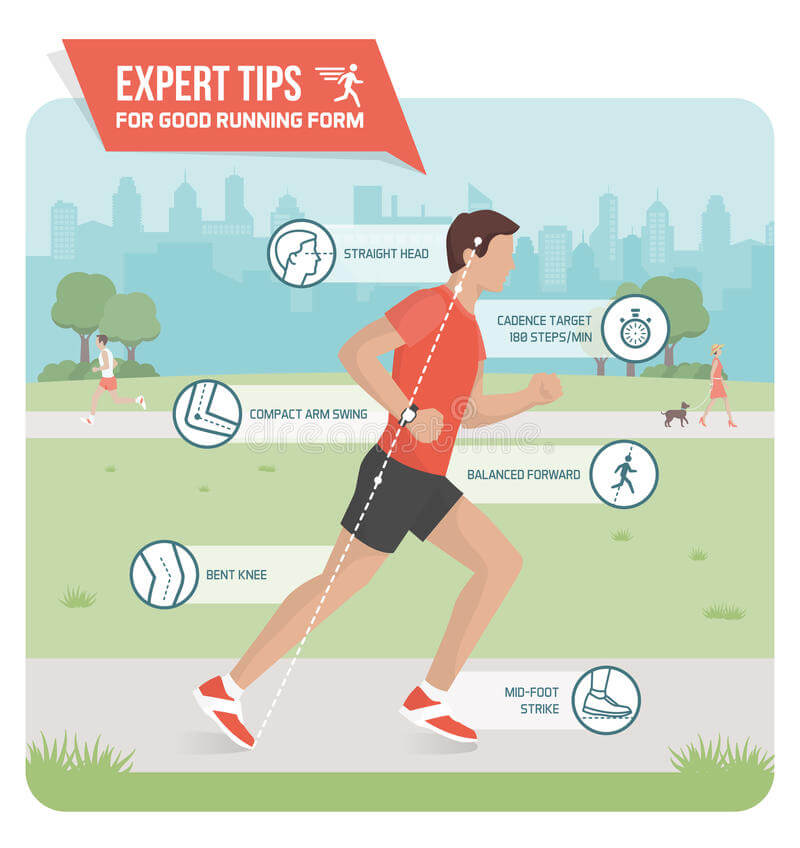5 Strategies For Improving Your Running Form And Efficiency

The ideal running form involves maintaining an upright posture, level hips, balanced arm swing, shorter stride, midfoot strike, controlled breathing, and relaxation. By focusing on these elements of proper form and technique, runners can improve their efficiency and reduce the risk of injury.
Let’s discuss tips for incorporating changes into your running routine to improve your running form and efficiency. Things like gradual progression, consistency, and proper recovery will have you improving in no time.
With these strategies, you can achieve your running goals while avoiding injury and maintaining motivation.
Importance of Running Form and Efficiency
Running form and efficiency are essential for runners of all levels, from beginners to professional athletes. Proper running form and technique can help prevent injuries, improve running economy, increase speed, and reduce fatigue.
Running with poor form increases the risk of injury to muscles, joints, and bones. On the other hand, having good running form helps to distribute the impact of each step more evenly, reducing the stress on the body and decreasing the likelihood of injury.

If you can improve your running form and efficiency, this can lead to better performance because it helps you to move more effectively. Optimizing your stride, arm swing, and breathing allows you to run faster and longer without feeling tired or experiencing discomfort.
Proper run biomechanics are often the key to achieving your goals as a runner.
Understanding Running Form
There are many small things you can remove from or add to your running habits to make changes in your form over time and become a more efficient runner.
Common Running Form Mistakes
Here are some of the most common running form mistakes that runners make:
Overstriding: Overstriding occurs when you take steps that are too long, which can lead to heel striking and increase the risk of injury.
Hunching over: Hunching over can lead to improper alignment and reduced oxygen intake, leading to fatigue and decreased performance.
Poor arm swing: An uncontrolled arm swing or swinging arms across the body can create inefficiencies in running form and lead to wasted energy.
Tight grip: Clenching your fists and tightening your arms can create tension in the upper body and reduce efficiency.
Incorrect foot strike: Landing too much on the heels or forefoot can increase the risk of injury and reduce efficiency.
Rigid upper body: Stiffening the upper body can increase tension in the muscles, decrease oxygen intake, and lead to inefficient running form.
Over-reliance on footwear: Relying too much on running shoes for support and cushioning can weaken the muscles and lead to a lack of proper form and technique.
Ideal running form
The ideal running form can vary slightly from runner to runner, depending on individual anatomy, fitness level, and other factors.
Here are some key elements of proper running form that can apply to most runners:
Upright posture: Stand tall with your head up, shoulders relaxed, and hips aligned.
Slight forward lean: Lean forward slightly from the ankles while maintaining a straight posture.
Level hips: Keep your hips level to prevent any unnecessary side-to-side movement and increase your range of motion.
Balanced arm swing: Swing your arms naturally back and forth, keeping your elbows bent at a 90-degree angle and hands relaxed.
Shorter stride: Take short, quick steps with your feet landing under your hips rather than in front of your body.
Midfoot strike: Land on the midfoot to distribute the impact of each stride more evenly and reduce stress on the body.
Controlled breathing: Breathe deeply and rhythmically, inhaling through the nose and exhaling through the mouth.
Relaxation: Avoid tensing the body and focus on relaxation and efficient movement.
5 Strategies for Improving Running Form and Efficiency
Does it feel like you’re expending more energy than necessary just to keep up your pace? You’re not alone, and there are simple strategies you can use to improve your running form and efficiency.
1. Body Positioning and Alignment
Proper body positioning and alignment are crucial to efficient running form and improved running stride. Ensure you’re standing tall with your head up, shoulders relaxed, and hips aligned.
You should avoid leaning too far forward or backward, as this can cause unnecessary stress on your joints and decrease your efficiency.
Also, remember to keep your core engaged to maintain stability and control throughout your run.

2. Cadence and Stride Length
Your running cadence and stride length can significantly impact your performance. You should strive for a cadence of around 180 steps per minute, which can help to reduce the impact of each stride and increase your efficiency.
Shorten your stride length and focus on quick, light steps to promote proper alignment and reduce the risk of injury.
3. Arm Swing and Posture
Your arm swing and posture can also affect your running form and efficiency. Keep your arms relaxed and swing naturally back and forth, with your elbows bent at a 90-degree angle. One important thing to remember is to avoid crossing your arms in front of your body.
This is a common running mistake and a great running tip. Doing this can create unnecessary tension and waste energy. Focus on maintaining an upright posture, with your shoulders, back, and chest open.
4. Breathing Techniques
Proper breathing techniques can help you maintain your energy and endurance throughout your run. Focus on deep, rhythmic breathing, inhaling through your nose and exhaling through your mouth. Take longer, deeper breaths during easy runs or recovery runs and shorter, faster breaths during tempo runs or high-intensity intervals.
Controlling your breathing can be a crucial part of being able to run faster for longer. If you fall into the trap of erratic breathing, you may find yourself totally blowing a workout or race.
5. Foot Strike and Landing
Paying attention to your foot strike and landing is important. Try landing softly on the midfoot or forefoot, rather than on your heels, to distribute the impact of each stride more evenly and reduce stress on your body.

You should also avoid overstriding, or taking steps that are too long, as this can lead to inefficient form and increased risk of injury. If you hear your foot slapping the ground with force, then this is a sign of poor landing technique.
Strengthening Exercises to Improve Running Form
There are many strength exercises worth incorporating into your routine. These exercises can help you improve your running form and increase your overall performance, as well as reduce the risk of running injuries.
By focusing on core exercises, glute and hip strengthening exercises, and plyometric exercises, you can develop the strength and stability you need to run with greater efficiency and confidence.
Core Exercises
A strong core is essential for maintaining proper alignment and stability throughout your run. Incorporate exercises that target your abs, lower back, and obliques to help improve your posture and prevent fatigue.
Planks, Russian twists, and bicycle crunches are all great examples of core exercises that can help improve your running form.
Glute and Hip-Strengthening Exercises
The glutes and hips play a critical role in running form, as they provide power and stability with each stride. Incorporate exercises such as squats, lunges, and hip bridges to strengthen these key muscle groups.
Single-leg squats and lateral band walks can also help target the glutes and hips in a functional way that mimics running mechanics. Exercises like lunges and squats also engage your quads, another important muscle for runners.
Hip bridges are great for your hamstrings, another muscle no runner should neglect.
Plyometric Exercises
Plyometric exercises are high-impact movements that can help improve your running form by increasing your explosive power and stability. Incorporate exercises such as box jumps, jump squats, and burpees into your routine to help build strength, endurance, and agility.
Plyometric exercises can also help reduce the impact of each stride, which can help prevent injuries and improve overall efficiency.
Remember to start with a warm-up, listen to your body, and progress gradually to prevent injury and optimize your results. With dedication and consistency, you can achieve your running goals and enjoy a healthier, more efficient running experience.
Latest Articles
 Is Running on a Treadmill Easier Than Running Outside?Runners have their own preferences, whether it is treadmill running, running outside on the road, or exploring trails. So...
Is Running on a Treadmill Easier Than Running Outside?Runners have their own preferences, whether it is treadmill running, running outside on the road, or exploring trails. So... Is It OK to Use Trail Running Shoes on the Road?While trail running shoes can be used on roads, especially in situations where a runner encounters mixed terrains or pref...
Is It OK to Use Trail Running Shoes on the Road?While trail running shoes can be used on roads, especially in situations where a runner encounters mixed terrains or pref... How to Fix Sore Quads After Running?Rest, ice, gentle stretching, and over-the-counter pain relievers can help soothe sore quads after running. Also, ensure ...
How to Fix Sore Quads After Running?Rest, ice, gentle stretching, and over-the-counter pain relievers can help soothe sore quads after running. Also, ensure ... 10 Fruits With The Most Electrolytes to Replace Sports DrinksThese fruits are high in electrolytes such as potassium, magnesium, and calcium, essential for hydration, muscle function...
10 Fruits With The Most Electrolytes to Replace Sports DrinksThese fruits are high in electrolytes such as potassium, magnesium, and calcium, essential for hydration, muscle function...

